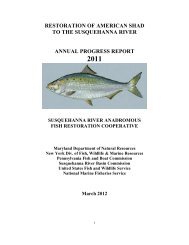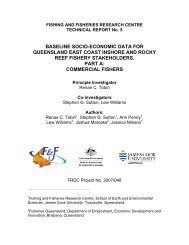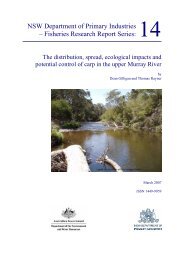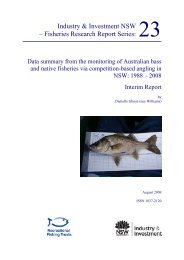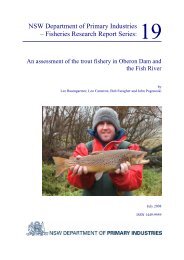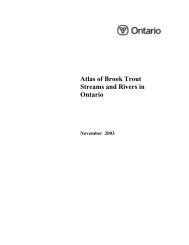Assessment of shark sighting rates by aerial ... - Fisheries Reports
Assessment of shark sighting rates by aerial ... - Fisheries Reports
Assessment of shark sighting rates by aerial ... - Fisheries Reports
You also want an ePaper? Increase the reach of your titles
YUMPU automatically turns print PDFs into web optimized ePapers that Google loves.
NSW DPI 7<br />
2. METHODS<br />
2.1. Study location<br />
The study was conducted at the northern side <strong>of</strong> Jervis Bay, NSW (35.0167ºS, 150.7311ºE). This is<br />
a large embayment (~112 km 2 ) with a substratum consisting primarily <strong>of</strong> sand and seagrass, and a<br />
topography <strong>of</strong>fering protection from winds and swells. The bay was located within a 30 min flight<br />
to the Albion Park airbase near Wollongong.<br />
2.2. Equipment<br />
Two aircraft were used in this study: A Cessna 182 fixed-wing aeroplane and a Robinson R44<br />
Clipper II helicopter. The fixed-wing company had considerable experience with <strong>aerial</strong> <strong>shark</strong><br />
detection, while the helicopter company had no prior experience. The aircrews <strong>of</strong> both aircraft<br />
consisted <strong>of</strong> a pilot, an observer to sight the <strong>shark</strong> analogues and a data recorder. Due to cockpit<br />
configurations, the observer looked out to the right in the fixed-wing aircraft and to the left in the<br />
helicopter.<br />
The artificial <strong>shark</strong> analogues consisted <strong>of</strong> 2.5 m (total length) plywood cutouts, painted a similar<br />
shade <strong>of</strong> grey to that <strong>of</strong> large <strong>shark</strong>s. The analogue shape was traced from a white <strong>shark</strong><br />
(Carcharodon carcharias) incidentally captured through the NSW DPI Shark Meshing (Bather<br />
Protection) Program. The head morphology was altered in a number <strong>of</strong> analogues to mimic bluntheaded<br />
tiger <strong>shark</strong>s (Galeocerdo cuvier) and hammerhead <strong>shark</strong>s (Sphyrna sp.) (Fig. 1). The<br />
hammerhead outline was traced from a stored head at the Cronulla <strong>Fisheries</strong> Research Centre <strong>of</strong><br />
Excellence, while the tiger <strong>shark</strong> head outline was drawn from a photograph taken <strong>by</strong> the lead<br />
author. Wire cables <strong>of</strong> sufficient length to allow the analogues to sit approximately horizontal in the<br />
water were attached to each corner, terminating in a single metal ring to which an anchor rope was<br />
attached. The analogues were inherently buoyant, although a small (3 cm) grey/yellow surface float<br />
was attached via a string to aid the boat crew in relocating submerged analogues. These floats were<br />
not visible to the aircraft observers.<br />
2.3. Depth trial<br />
A series <strong>of</strong> stations consisting <strong>of</strong> a small galvanised pulley attached to 28 kg <strong>of</strong> coal chain as an<br />
anchor were deployed in 6 m and 12 m water depths. A 6 mm rope was threaded through the<br />
pulley, with one end attached to a <strong>shark</strong> analogue, and the other end held taut <strong>by</strong> a crewmember on<br />
a 5.7 m runabout vessel anchored ~20 m away. Each analogue was initially sunk to a depth <strong>of</strong> 5 – 6<br />
m, where<strong>by</strong> an aircraft would then orbit (fixed-wing) or hover (helicopter) at 500 ft (~150 m) above<br />
the position <strong>of</strong> the analogue while it was slowly raised towards the surface <strong>by</strong> the boat crew<br />
member releasing the rope. The aircrew radioed the boat once the analogue was seen, at which time<br />
the depth <strong>of</strong> the analogue below the water surface was digitally measured. The boat crew member<br />
randomly changed the speed <strong>of</strong> the surfacing analogue to prevent it becoming visible to the<br />
aircrews after a predictable period. Each analogue type (white <strong>shark</strong>, tiger <strong>shark</strong> and hammerhead<br />
<strong>shark</strong>) was tested three times in each <strong>of</strong> the two water depths for each aircraft. Water turbidity was<br />
established using a 25 cm secchi disk deployed in the shade <strong>of</strong> the boat throughout the day. Data<br />
was log(x+1) transformed to reduce variance homogeneity, and analysed using ANOVA in SPSS<br />
17. Aircraft, depth and analogue type were treated as fixed factors, and day as a random factor.<br />
<strong>Assessment</strong> <strong>of</strong> <strong>shark</strong> <strong>sighting</strong> <strong>rates</strong> <strong>by</strong> <strong>aerial</strong> beach patrols Robbins et al.




